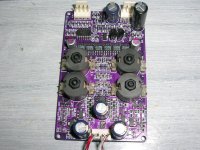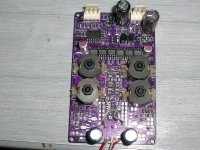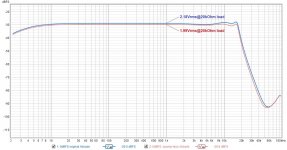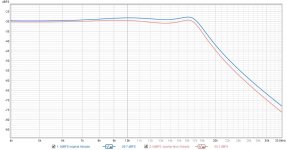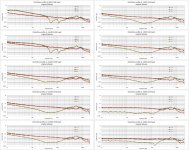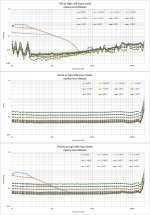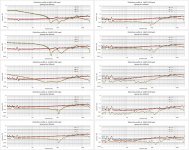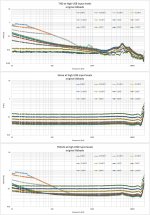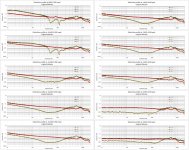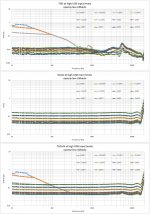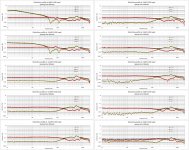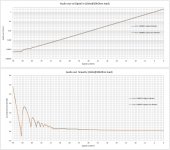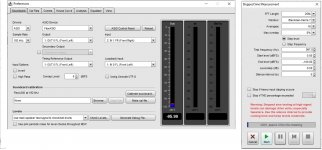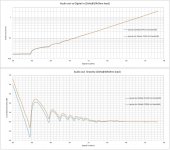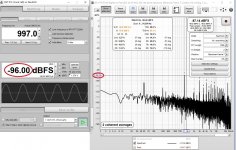The PCBs for the balancer came back yesterday and it didn't take too long to populate the 5 logic chips. But the output was crackly, and I tracked this down to U5 not working correctly. So I switched it out and this made things worse, no sound at all. I've reluctantly come to the conclusion that my batch of HEF4517s is suspect. I decided to replace that chip with 12 74HC595s on the re-spin which will increase the size of the PCB by 100%. The upside is - it'll work at higher sample rates than NOS since the HC shift-regs are much, much faster than the 4000-series CMOS device. Already listening to Jennifer Warnes through the prototype feeding a pair of Doratis:

Balanced does seem to make things a touch more 'agile' and holographic. Definitely a keeper.
Balanced does seem to make things a touch more 'agile' and holographic. Definitely a keeper.
A few days ago I received two boards from Abraxalito.
One original Abbado with OPA2209 opamp and one opamp-less Abbado.
They both require 12Vdc. The onboard PSU section is the same on both.
Their audio out is about the same. Original outputs 2.18Vrms, opamp-less outputs 1.99Vrms (0dBFS 1kHz input, with 20kOhm load at the output)
George
One original Abbado with OPA2209 opamp and one opamp-less Abbado.
They both require 12Vdc. The onboard PSU section is the same on both.
Their audio out is about the same. Original outputs 2.18Vrms, opamp-less outputs 1.99Vrms (0dBFS 1kHz input, with 20kOhm load at the output)
George
Attachments
I did some basic distortion profile measurements (step freq with REW)
Attachments
One original Abbado with OPA2209 opamp and one opamp-less Abbado.
They both require 12Vdc. The onboard PSU section is the same on both.
Their audio out is about the same. Original outputs 2.18Vrms, opamp-less outputs 1.99Vrms (0dBFS 1kHz input, with 20kOhm load at the output)
Glad the DACs arrived safely George.
Interesting plots of the frequency response - you'll note that the 'original Abbado' has NOS droop correction in the opamp stage which results in a rising response (by about 2dB) at the higher frequencies.
Thanks for sharing all this... And how do they sound?
In comparison to existing DACs, and also against each other, what would be your POV?
Have fun George
Claude
In comparison to existing DACs, and also against each other, what would be your POV?
Have fun George
Claude
I decided to do again the distortion profile tests shown two posts above. There was something wrong there (peaks at subharmonics of 50Hz).
Now it is easier to see the better behaviour of the opamp-less Abbado at levels below -0.1dBFS at the low to mid frequencies.
Claude, I haven't audioned the DACs yet
George
Now it is easier to see the better behaviour of the opamp-less Abbado at levels below -0.1dBFS at the low to mid frequencies.
Claude, I haven't audioned the DACs yet

George
Attachments
Thanks George...
From experience I would say it is sadly difficult to say how these figures affect the sound of the unit, which is IMHO at the end the ilportant thing.
I am not sure how to interpret all those figures, other than for the original unit: "there are indeed a lot of distorsions at or very near peak level in the sub 100Hz region"
Having said that, I am not sure there is a lot of music recorded at 0dBFs to -0.1dBFS levels. Plus when looking at the usefull harmonic structure of the distorsions, one sees at these values potentialy harmless H3 (gives often boost to beats) mainly and then H2. Apart from that finding, I would say distorsions are anyway low / lower than many things when listening to music in real life, quite at the units noise level, so probably secondary to listener preference hence asking how does this little music box (it isn't a pure HIFI modern DAC in the sense of today's vanishing THD +N units) sounds.
Oh, and the original unit seems to have a tuning where in this critical area listed above, H2 has been made dominant around the voice principal tone, our ears are for sure very sensitive in this 0.4 to 2kHz region, so these THD (again at very peak levels) are also probably not making ears bleed. Intersting to see that at other / quiter levels, the H2 is dominant across the audio range up to the treble where it is quite on a par with H3 and anyway, as said, THD + N probably secondary to listening preferences.
Of course it is early in the morning and I could be very wrong with my reading and all this LOL!
Claude
From experience I would say it is sadly difficult to say how these figures affect the sound of the unit, which is IMHO at the end the ilportant thing.
I am not sure how to interpret all those figures, other than for the original unit: "there are indeed a lot of distorsions at or very near peak level in the sub 100Hz region"
Having said that, I am not sure there is a lot of music recorded at 0dBFs to -0.1dBFS levels. Plus when looking at the usefull harmonic structure of the distorsions, one sees at these values potentialy harmless H3 (gives often boost to beats) mainly and then H2. Apart from that finding, I would say distorsions are anyway low / lower than many things when listening to music in real life, quite at the units noise level, so probably secondary to listener preference hence asking how does this little music box (it isn't a pure HIFI modern DAC in the sense of today's vanishing THD +N units) sounds.
Oh, and the original unit seems to have a tuning where in this critical area listed above, H2 has been made dominant around the voice principal tone, our ears are for sure very sensitive in this 0.4 to 2kHz region, so these THD (again at very peak levels) are also probably not making ears bleed. Intersting to see that at other / quiter levels, the H2 is dominant across the audio range up to the treble where it is quite on a par with H3 and anyway, as said, THD + N probably secondary to listening preferences.
Of course it is early in the morning and I could be very wrong with my reading and all this LOL!
Claude
Moving on the op-amp less version... and carrying on with my possibly completely silly interpretation of all this, so please fell free to correct me!
One can see the main finding between the critical 0dBFS and -0.1dBFS range, but here one could say that the range has been made more begnin being only half, say really critical down to -0.05dBFs . Not sure there is a lot of music recorded at this dangerously high level, perhaps at mastering, who knows?
In comparison with the normal version, this op-amp less unit has less distorsions at high levels in the bass region, and is quite comparable otherwise. The harmonic profile is similar, but the op-amp less version shines with lower values and a better / more constant relationship between H2 and H3 across the range... possibly at the cost of slightly higher H3 in the treble.
As long as it sounds right, no harm IMHO, perhaps the op-amp less version sounds more consistant across awider range and more pleasing to the ears, with a possible small downside in the treble were sounds could be more perceing... but since when could one foretell the sound of a unit based on these measurements anyway GLOL?
Good to have these though, as I can't see any show stopper or terrible cheating... Ok, I admit, I am not an ASR fan when it comes to sound and measurements.
Care to elaborate your findings, anyone? Just to see if my morning's feeling is about right... could be intersting to compare these values with Celibidace or more uprange models from our DAC wizard...
Have a nice day and thanks again for sharing George
Claude
One can see the main finding between the critical 0dBFS and -0.1dBFS range, but here one could say that the range has been made more begnin being only half, say really critical down to -0.05dBFs . Not sure there is a lot of music recorded at this dangerously high level, perhaps at mastering, who knows?
In comparison with the normal version, this op-amp less unit has less distorsions at high levels in the bass region, and is quite comparable otherwise. The harmonic profile is similar, but the op-amp less version shines with lower values and a better / more constant relationship between H2 and H3 across the range... possibly at the cost of slightly higher H3 in the treble.
As long as it sounds right, no harm IMHO, perhaps the op-amp less version sounds more consistant across awider range and more pleasing to the ears, with a possible small downside in the treble were sounds could be more perceing... but since when could one foretell the sound of a unit based on these measurements anyway GLOL?
Good to have these though, as I can't see any show stopper or terrible cheating... Ok, I admit, I am not an ASR fan when it comes to sound and measurements.
Care to elaborate your findings, anyone? Just to see if my morning's feeling is about right... could be intersting to compare these values with Celibidace or more uprange models from our DAC wizard...
Have a nice day and thanks again for sharing George
Claude
I've been wondering if its high time to dump the TDA1387 on future DAC development work. I'm not enamoured with any of the other traditional audio DAC chips as I'm hankering after much more current to make the I/V stage easier to get low enough noise.
Communications DAC chips have lots of current available (typically up to 20mA) just they're not normally available in 16bits. So I wanted to listen to what's lost with fewer bits - here's my first prototype with AD9764 which is a 14bit chip, parallel input. I'm using the filters and I/V stage from Abbado here. Initial listening seems to indicate the AD9764 is lower noise in the midrange and HF at least than with Abbado (6 * TDA1387), jury's out on LF noise. Next step is to introduce some oversampling and try to get the 14bits of these chips to do the work of a 16bit chip. Recall that ESS DAC chips only use a 6bit DAC to achieve their ultra-low noise and THD, in conjunction with oversampling.

Communications DAC chips have lots of current available (typically up to 20mA) just they're not normally available in 16bits. So I wanted to listen to what's lost with fewer bits - here's my first prototype with AD9764 which is a 14bit chip, parallel input. I'm using the filters and I/V stage from Abbado here. Initial listening seems to indicate the AD9764 is lower noise in the midrange and HF at least than with Abbado (6 * TDA1387), jury's out on LF noise. Next step is to introduce some oversampling and try to get the 14bits of these chips to do the work of a 16bit chip. Recall that ESS DAC chips only use a 6bit DAC to achieve their ultra-low noise and THD, in conjunction with oversampling.
Hi Abrax
I see you are looking for excuses to torture your wife with new pcb designs. 😉
All your 1378 NOS DACs I have measured, end at 15bits depth and the linearity waves +/-0.5dB from the 13 bits depth, regardless of what outboard PSU is used.
I will be surprised if other NOS 16bit DACs do better.
I have measured one DAC with an ES9018 chip and the linearity waves +/-0.5dB from the 14 bits depth. Another with an AK4396 chip sails down to 24bits depth with the linearity waving +/-0.5dB from the 20bits depth
We already know that NOS DACs do not excel in such measurements. An old soul had said something as a warning though http://www.sakurasystems.com/articles/Non-oversampling-DAC.html
What I mean is, please try, test and listen to the AD9764 as NOS, then make an OS version and compare.

George
I see you are looking for excuses to torture your wife with new pcb designs. 😉
All your 1378 NOS DACs I have measured, end at 15bits depth and the linearity waves +/-0.5dB from the 13 bits depth, regardless of what outboard PSU is used.
I will be surprised if other NOS 16bit DACs do better.
I have measured one DAC with an ES9018 chip and the linearity waves +/-0.5dB from the 14 bits depth. Another with an AK4396 chip sails down to 24bits depth with the linearity waving +/-0.5dB from the 20bits depth
We already know that NOS DACs do not excel in such measurements. An old soul had said something as a warning though http://www.sakurasystems.com/articles/Non-oversampling-DAC.html
What I mean is, please try, test and listen to the AD9764 as NOS, then make an OS version and compare.

George
Attachments
I need to break the news about new PCBs gently 🙂
How did you measure the linearity? If you use a wide enough bandwidth then the noise is going to affect linearity measurements. I could try checking with single tone and FFT.
Do you expect linearity to change according to the degree of OS for any chip? (I've been listening in 2X OS as I only have 5th order filters and no droop correction).
How did you measure the linearity? If you use a wide enough bandwidth then the noise is going to affect linearity measurements. I could try checking with single tone and FFT.
Do you expect linearity to change according to the degree of OS for any chip? (I've been listening in 2X OS as I only have 5th order filters and no droop correction).
Abrax
I repeated the test at 44.1KHz-24bit (see 2nd attachment and compare results).
As distortion profile testing requires 192kHz bandwidt, I do all the testings at 192kHz/24dB for not to change settings at three different windows (and mix things up when I forget to change one).
The x16 averaging in these linearity tests is essential for noise-immunized results but makes each test run a multi hour process.
George
I repeated the test at 44.1KHz-24bit (see 2nd attachment and compare results).
As distortion profile testing requires 192kHz bandwidt, I do all the testings at 192kHz/24dB for not to change settings at three different windows (and mix things up when I forget to change one).
The x16 averaging in these linearity tests is essential for noise-immunized results but makes each test run a multi hour process.
George
Attachments
Last edited:
Ah so noise reduction is done by running many measurements and averaging the results. I wonder if I can see those ripples at lower level in an FFT. I don't feel like running multi-hour long tests if there turns out to be a quicker way.
Abrax
You can use the generator in single test freq in conjunction with the FFT panel.
Start the generator from very low level and place the cursor over the peak of the fundamental.
On the dBFS scale the amplitude of the fundamental will be shown in blue.
Write down the gen level and that shown on the FFT dBFS scale.
Increase the generator level in small increments and write down the pairs of dBFS readings (the two red circles at the attachment).
Where the incremental change of the generator’s level does not match the incremental change of the FFT reading, there is a non-linear region.
You can then document this by running the step level procedure over a limited frequency range for to save time. 🙂
Non linearity ripples can be shown even with lower averaging.
George
You can use the generator in single test freq in conjunction with the FFT panel.
Start the generator from very low level and place the cursor over the peak of the fundamental.
On the dBFS scale the amplitude of the fundamental will be shown in blue.
Write down the gen level and that shown on the FFT dBFS scale.
Increase the generator level in small increments and write down the pairs of dBFS readings (the two red circles at the attachment).
Where the incremental change of the generator’s level does not match the incremental change of the FFT reading, there is a non-linear region.
You can then document this by running the step level procedure over a limited frequency range for to save time. 🙂
Non linearity ripples can be shown even with lower averaging.
George
Attachments
Continuing the testing on the original and on the opamp-less Abbado, I looked into their behavior with different loads at their output. As usual I was testing at 1kHz. 
The original Abbado showed the typical behavior. Below some 200 Ohm load, output level drops sharply and distortion rises to the sky. (attachment 1)
The opamp-less Abbado’s behavior was rather untypical. Gradual output drop with heavier loading but distortion remained very low, only the THD+N increasing slightly. (attachment 2). That seemed suspiciously too good.
I decided to run some fast distortion sweeps (not quite accurate but good enough to show trends).
Well, the original Abbado shows the THD increase across the freq spectrum for load below 200 Ohm (attachment 3).
The opamp-less Abbado shows THD increasing sharply only btn 4KHZ and 10kHz for loads below 1kOhm (attachment 4)
That said, an overall good behavior from the opamp-less Abbado. 🙂
George

The original Abbado showed the typical behavior. Below some 200 Ohm load, output level drops sharply and distortion rises to the sky. (attachment 1)
The opamp-less Abbado’s behavior was rather untypical. Gradual output drop with heavier loading but distortion remained very low, only the THD+N increasing slightly. (attachment 2). That seemed suspiciously too good.
I decided to run some fast distortion sweeps (not quite accurate but good enough to show trends).
Well, the original Abbado shows the THD increase across the freq spectrum for load below 200 Ohm (attachment 3).
The opamp-less Abbado shows THD increasing sharply only btn 4KHZ and 10kHz for loads below 1kOhm (attachment 4)
That said, an overall good behavior from the opamp-less Abbado. 🙂
George
Attachments
-
 1 1kHz THD vs load original Abbado.jpg142.2 KB · Views: 119
1 1kHz THD vs load original Abbado.jpg142.2 KB · Views: 119 -
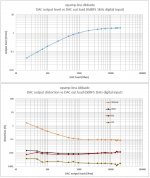 2 1kHz THD vs load opamp-less Abbado.jpg144.3 KB · Views: 113
2 1kHz THD vs load opamp-less Abbado.jpg144.3 KB · Views: 113 -
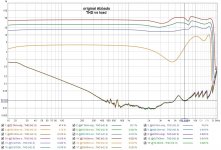 3 THD vs load original Abbado.jpg179.1 KB · Views: 100
3 THD vs load original Abbado.jpg179.1 KB · Views: 100 -
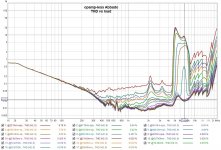 4 THD vs load opamp-less Abbado.jpg203.4 KB · Views: 105
4 THD vs load opamp-less Abbado.jpg203.4 KB · Views: 105 -
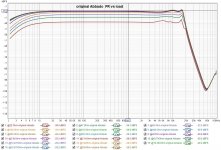 5 FR vs load original Abbado.jpg269.9 KB · Views: 96
5 FR vs load original Abbado.jpg269.9 KB · Views: 96 -
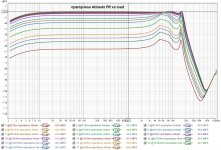 6 FR vs load opamp-less Abbado.jpg295.5 KB · Views: 95
6 FR vs load opamp-less Abbado.jpg295.5 KB · Views: 95
Last edited:
George - the opamp-less Abbado I sent you has a 1kohm resistor for I/V and that's the output impedance when you send the voltage across that resistor directly out to your test equipment. The 1kohm output impedance is not designed to drive any external equipment - and if you load it with any significant resistance the frequency response of the CLCLC filter gets messed up. But seeing as its being driven with a current source distortion isn't going to change much with loading. You might be seeing the effect of the FR being bent out of shape implicitly in your attachment #4. I note attachment #6 shows this explicitly - with lower and lower impedances the Q goes sky-high at the corner frequency.
I'd just like to point out here that 'opamp-less' shouldn't be interpreted in the same manner as in 'Dorati is an opamp-less version of Kubelik' because in Dorati there's a buffer and an EQ stage implemented in discrete form. In this opamp-less Abbado there is neither of these stages because its intended only as a research platform, not a finalized DAC design.
I'd just like to point out here that 'opamp-less' shouldn't be interpreted in the same manner as in 'Dorati is an opamp-less version of Kubelik' because in Dorati there's a buffer and an EQ stage implemented in discrete form. In this opamp-less Abbado there is neither of these stages because its intended only as a research platform, not a finalized DAC design.
Last edited:
Hi Abraxalito.
You are right. I had asked you this bufferless opampless Abbado for running experiments.
It's output impedance can be infered from Attachment 2 on my previous post (-6dB drop at 1kOhm load).
That said, the current source works very well for any reasonable DAC line load (not for driving headphones).
Headphones too will be driven with your buffered Dorati in an optimum way
Keep up the good work.
George
You are right. I had asked you this bufferless opampless Abbado for running experiments.
It's output impedance can be infered from Attachment 2 on my previous post (-6dB drop at 1kOhm load).
That said, the current source works very well for any reasonable DAC line load (not for driving headphones).
Headphones too will be driven with your buffered Dorati in an optimum way
Keep up the good work.

George
It's output impedance can be infered from Attachment 2 on my previous post (-6dB drop at 1kOhm load).
That is indeed what I looked at to figure out what kind of output stage you were measuring there George. Once I saw the 6dB drop at 1k load I instantly understood the answer - 'none'.😎
I've built a current source drive DAC for headphones in earlier times - I don't think I talked about it here but there's a picture on my Hackaday page : https://hackaday.io/project/176711-current-source-drive-for-headphones
I guess you are in the "less is more" pool with both feet (but with a reasoning of an EE) 🙂
George
George
I was looking for some recordings as test files for to investigate the influence of DACs on timbre, dynamics, sharp transitions and decay of sound.
Two recordings from Maurice Ohana compositions one for 10 string quitar and one for piano seems good.
The digital transfers are on 1a ( * ) and 2a ( ** ) files
(*)extract from: "Si le jour parait, per chitarra a 10 corde" (1963)
(**)extract from: "24 Préludes pour piano" (1972 - 1973)
The 1b, 2b are what it comes out when played through the original Abbado DAC (USB input)
The 1c, 2c are what it comes out when played through the opamp-less Abbado DAC (USB input)
The 1d, 2d are what it comes out when played through the SMSL M500 DAC (USB input, apodising filter). This DAC is a loan from member alexopth1512
All DAC analog output was recorded through my EMU-0404 soundcard (AK5485A ADC)
Uploaded files are level matched and time alligned (guitar files to each other, piano files to each other)
1a_guitar extract_parent file.wav
https://www.dropbox.com/s/xpe95pc56fw5dxl/1a_guitar extract_parent file.wav?dl=0
1b_guitar extract_original Abbado DAC.wav
https://www.dropbox.com/s/gd5smonlj9euh4w/1b_guitar extract_original Abbado DAC.wav?dl=0
1c_guitar extract_opamp-less Abbado DAC.wav
https://www.dropbox.com/s/zgyr42dmprymbiu/1c_guitar extract_opamp-less Abbado DAC.wav?dl=0
1d_guitar extract_SMSL M500 DAC.wav
https://www.dropbox.com/s/uhdbjfcpl1lycyl/1d_guitar extract_SMSL DAC.wav?dl=0
2a_piano extract_parent file.wav
https://www.dropbox.com/s/e6rs3tumonnnudw/2a_piano extract_parent file.wav?dl=0
2b_piano extract_original Abbado DAC.wav
https://www.dropbox.com/s/s0q1dbmq1hrvs7e/2b_piano extract_original Abbado DAC.wav?dl=0
2c_piano extract_opamp-less Abbado DAC.wav
https://www.dropbox.com/s/9t9i6xl2uw0hfs3/2c_piano extract_opamp-less Abbado DAC.wav?dl=0
2d_piano extract_SMSL M500 DAC.wav
https://www.dropbox.com/s/6ca01l7boiq9s8y/2d_piano extract_SMSL DAC.wav?dl=0
The uploads will be available for a week at dropbox.
George
Two recordings from Maurice Ohana compositions one for 10 string quitar and one for piano seems good.
The digital transfers are on 1a ( * ) and 2a ( ** ) files
(*)extract from: "Si le jour parait, per chitarra a 10 corde" (1963)
(**)extract from: "24 Préludes pour piano" (1972 - 1973)
The 1b, 2b are what it comes out when played through the original Abbado DAC (USB input)
The 1c, 2c are what it comes out when played through the opamp-less Abbado DAC (USB input)
The 1d, 2d are what it comes out when played through the SMSL M500 DAC (USB input, apodising filter). This DAC is a loan from member alexopth1512
All DAC analog output was recorded through my EMU-0404 soundcard (AK5485A ADC)
Uploaded files are level matched and time alligned (guitar files to each other, piano files to each other)
1a_guitar extract_parent file.wav
https://www.dropbox.com/s/xpe95pc56fw5dxl/1a_guitar extract_parent file.wav?dl=0
1b_guitar extract_original Abbado DAC.wav
https://www.dropbox.com/s/gd5smonlj9euh4w/1b_guitar extract_original Abbado DAC.wav?dl=0
1c_guitar extract_opamp-less Abbado DAC.wav
https://www.dropbox.com/s/zgyr42dmprymbiu/1c_guitar extract_opamp-less Abbado DAC.wav?dl=0
1d_guitar extract_SMSL M500 DAC.wav
https://www.dropbox.com/s/uhdbjfcpl1lycyl/1d_guitar extract_SMSL DAC.wav?dl=0
2a_piano extract_parent file.wav
https://www.dropbox.com/s/e6rs3tumonnnudw/2a_piano extract_parent file.wav?dl=0
2b_piano extract_original Abbado DAC.wav
https://www.dropbox.com/s/s0q1dbmq1hrvs7e/2b_piano extract_original Abbado DAC.wav?dl=0
2c_piano extract_opamp-less Abbado DAC.wav
https://www.dropbox.com/s/9t9i6xl2uw0hfs3/2c_piano extract_opamp-less Abbado DAC.wav?dl=0
2d_piano extract_SMSL M500 DAC.wav
https://www.dropbox.com/s/6ca01l7boiq9s8y/2d_piano extract_SMSL DAC.wav?dl=0
The uploads will be available for a week at dropbox.
George
- Home
- Source & Line
- Digital Line Level
- lingDAC - cost effective RBCD multibit DAC design
